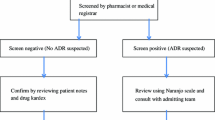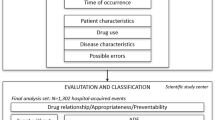Abstract
Objective: Adverse drug reactions (ADRs) are a well-known cause of hospital admission. Nevertheless a quantitative estimate of the preventability of and physicians’ awareness of these reactions is lacking.
Study Design and Methods: Using intensive bedside and computer-assisted drug surveillance methods a 13-month prospective pharmacoepidemiological survey was carried out on patients admitted to two medical wards of the Erlangen-Nuremberg University Hospital in Erlangen, Germany. This study aimed to define the incidence of preventable and unavoidable ADRs. In addition we investigated the awareness of the physicians to ADRs at the time of admission and the rate of contraindicated pre-admission prescriptions.
Results: In 78 (8.5%) of 915 (10.9%) admissions a total of 102 (42 preventable) community-acquired ADRs were detected on admission. In 45 (3.8%) of the admissions ADRs led directly to hospitalisation. 56.9% of the ADRs were not recognised by the attending physician on admission. Marked correlation was found between the awareness of ADRs and their probability and severity scores (r = 0.85 and r = 0.94, respectively; p < 0.05). The most frequently detected ADRs were due to direct toxicity and secondary pharmacological effects. Idiosyncratic reactions were often missed and 18.6% of all drugs prescribed prior to admission were contraindicated. Leading the list were diuretics, analgesics/NSAIDs and antipsychotics/sedatives.
Conclusions: Awareness of existing ADRs on hospital admission and appropriate prescribing prior to hospital admission require attention. Early detection of ADRs on hospital admission can be achieved by the use of computer support systems. Many ADRs could be prevented by adhering to indications and contraindications.




Similar content being viewed by others
References
Bates DW, Spell N, Cullen DJ, et al. The costs of adverse drug events in hospitalized patients: Adverse Drug Events Prevention Study Group. JAMA 1997; 277(4): 307–11
Lakshmanan MC, Hershey CO, Breslau D. Hospital admissions caused by iatrogenic disease. Arch Intern Med 1986; 146(10): 1931–4
Chyka PA. How many deaths occur annually from adverse drug reactions in the United States? Am J Med 2000; 109(2): 122–30
Leape LL, Brennan TA, Laird N, et al. The nature of adverse events in hospitalized patients: results of the Harvard Medical Practice Study II. N Engl J Med 1991; 324(6): 377–84
Hallas J, Harvald B, Gram LF, et al. Drug related hospital admissions: the role of definitions and intensity of data collection, and the possibility of prevention. J Intern Med 1990; 228(2): 83–90
Einarson TR. Drug-related hospital admissions. Ann Pharmacother 1993; 27(7-8): 832–40
Bigby J, Dunn J, Goldman L, et al. Assessing the preventability of emergency hospital admissions: a method for evaluating the quality of medical care in a primary care facility. Am J Med 1987; 83(6): 1031–6
Evans RS, Pestotnik SL, Classen DC, et al. A computer-assisted management program for antibiotics and other antiinfective agents. N Engl J Med 1998; 338(4): 232–8
Dormann H, Muth-Selbach U, Krebs S, et al. Incidence and costs of adverse drug reactions during hospitalisation: computerised monitoring versus stimulated spontaneous reporting. Drug Saf 2000; 22(2): 161–8
Bates DW, Cohen M, Leape LL, et al. Reducing the frequency of errors in medicine using information technology. J Am Med Inform Assoc 2001; 8(4): 299–308
Honigman B, Lee J, Rothschild J, et al. Using computerized data to identify adverse drug events in outpatients. J Am Med Inform Assoc 2001; 8(3): 254–66
Jha AK, Kuperman GJ, Rittenberg E, et al. Identifying hospital admissions due to adverse drug events using a computer-based monitor. Pharmacoepidemiol Drug Saf 2001; 10(2): 113–9
Walton RT, Harvey E, Dovey S, et al. Computerised advice on drug dosage to improve prescribing practice. Available in The Cochrane Library [database on disk and CD ROM]. Updated quarterly. The Cochrane Collaboration; issue 1. Oxford Update Software, 2001: CD002894
Bates DW, Evans RS, Murff H, et al. Detecting adverse effects using information technology. J Am Med Inform Assoc 2003; 10: 115–28
Dormann H, Krebs S, Muth-Selbach U, et al. Adverse drug reactions in patients with gastroenterological diseases: does age increase the risk? Aliment Pharmacol Ther 2001; 15(2): 171–80
Charlson ME, Pompei P, Ales KL, et al. A new method of classifying prognostic comorbidity in longitudinal studies: development and validation. J Chronic Dis 1987; 40(5): 373–83
Bundesverband der pharmazeutischen Industrie e.V. (BPI) VfAeVV BdAeVB, Verband aktiver Pharmaunternehmer e.V. (VAP). Zusammenstellung von Gegenanzeigen, Anwendungsbeschränkungen, Neben- Wechselwirkungen und Intoxikationen. Rote Liste Service GmbH; 2000
Edwards IR, Aronson JK. Adverse drug reactions: definitions, diagnosis, and management. Lancet 2000; 356(9237): 1255–9
Naranjo CA, Busto U, Sellers EM, et al. A method for estimating the probability of adverse drug reactions. Clin Pharmacol Ther 1981; 30(2): 239–45
Schumock GT, Thornton JP. Focusing on the preventability of adverse drug reactions [letter]. Hosp Pharm 1992; 27(6): 538
Chan TY, Chan JC, Tomlinson B, et al. Adverse reactions to drugs as a cause of admissions to a general teaching hospital in Hong Kong. Drug Saf 1992; 7(3): 235–40
Huic M, Mucolic V, Vrhovac B, et al. Adverse drug reactions resulting in hospital admission. Int J Clin Pharmacol Ther 1994; 32(12): 675–82
Hallas J, Jensen KB, Grodum E, et al. Drug-related admissions to a department of medical gastroenterology: the role of self-medicated and prescribed drugs. Scand J Gastroenterol 1991; 26(2): 174–80
Gandhi TK, Burstin HR, Cook EF, et al. Drug complications in outpatients. J Gen Intern Med 2000; 15(3): 149–54
Bates DW, Cullen DJ, Laird N, et al. Incidence of adverse drug events and potential adverse drug events: implications for prevention. ADE Prevention Study Group. JAMA 1995; 274(1): 29–34
Rothschild JM, Bates DW, Leape LL. Preventable medical injuries in older patients. Arch Intern Med 2000; 160(18): 2717–28
Gurwitz JH, Field TS, Avorn J, et al. Incidence and preventability of adverse drug events in nursing homes. Am J Med 2000; 109(2): 87–94
Smith JW, Seidl LG, Cluff LE. Studies on the epidemiology of adverse drug reactions: V. clinical factors influencing susceptibility. Ann Intern Med 1966; 65(4): 629–40
Bates DW, Miller EB, Cullen DJ, et al. Patient risk factors for adverse drug events in hospitalized patients: ADE Prevention Study Group. Arch Intern Med 1999; 159(21): 2553–60
Kohler GI, Bode-Boger SM, Busse R, et al. Drug-drug interactions in medical patients: effects of in-hospital treatment and relation to multiple drug use. Int J Clin Pharmacol Ther 2000; 38(11): 504–13
Gosney M, Tallis R. Prescription of contraindicated and interacting drugs in elderly patients admitted to hospital. Lancet 1984; II(8402): 564–7
Waxman HS, Worley WE. Computer-assisted adult medical diagnosis: subject review and evaluation of a new microcomputer-based system. Medicine (Baltimore) 1990; 69(3): 125–36
Reducing doctors’ errors. BMJ 1977; 1 (6073): 1412
McDonald CJ. Protocol-based computer reminders, the quality of care and the non-perfectability of man. N Engl J Med 1976; 295(24): 1351–5
Acknowledgments
This study was supported by grants from BMBF No. EC 9403/7, ELAN No. 98.07.30–1 and Marohnstiftung No. Bru/2001. The authors would like to thank Dr Stephan Rietbrock for his advice and encouragement throughout this study and his statistical analysis. The authors have provided no information on conflicts of interest directly relevant to the content of this study.
Author information
Authors and Affiliations
Corresponding author
Rights and permissions
About this article
Cite this article
Dormann, H., Criegee-Rieck, M., Neubert, A. et al. Lack of Awareness of Community-Acquired Adverse Drug Reactions Upon Hospital Admission. Drug-Safety 26, 353–362 (2003). https://doi.org/10.2165/00002018-200326050-00004
Published:
Issue Date:
DOI: https://doi.org/10.2165/00002018-200326050-00004




